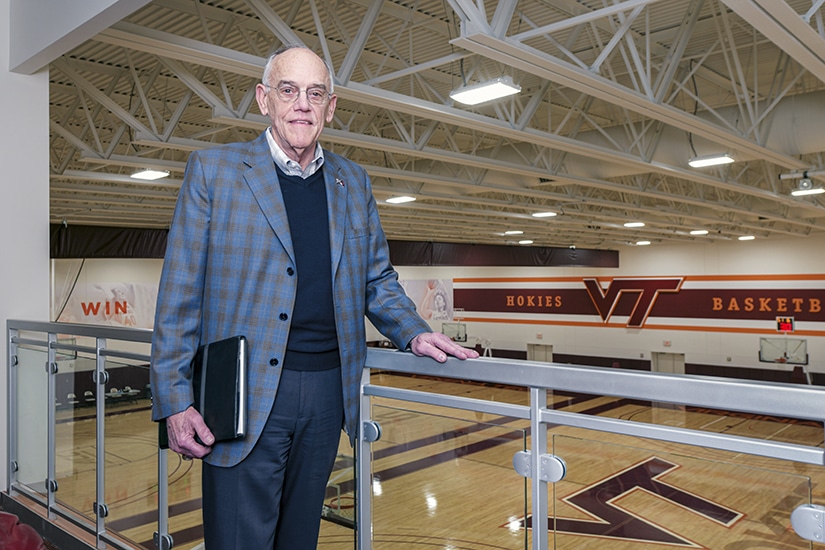|
Getting your Trinity Audio player ready...
|
Living across from the Cincinnati River and nearby Crosley Field, the former ballpark of Major League Baseball’s Cincinnati Reds, Tom Gabbard grew up dreaming of one day becoming a professional baseball player and playing amongst his boyhood heroes.

“I used to listen to the Reds every night on the radio and I did really well in Little League and always made the all-star game,” Gabbard recalls. “But I stopped growing and the world passed me by physically, so I quit baseball and started playing tennis.”
He played tennis at Brevard Junior College and transferred to the University of Florida. Upon graduating in 1968, he joined the Army and served in Vietnam. Once home, Gabbard spent 20 years in the real estate business, eventually opening his own company with his wife in Gainesville, Florida.
One of his clients was Jim Weaver, associate athletic director at the University of Florida, who wound up becoming a close friend and brought Gabbard on at the University of Nevada, Las Vegas, and eventually at Virginia Tech when Weaver himself took the athletic director’s job there.
Today, Gabbard serves as senior associate athletic director of facilities and operations for Virginia Polytechnic Institute and State University (VT), charged with new construction and maintenance of the school’s athletics facilities, as well as supervising the university’s athletics facilities managers and game operations people (such as ushers, ticket takers, referees, and police). He’s also the sport administrator for men’s basketball, men’s and women’s tennis, and men’s and women’s golf.
“Anything that’s a capital project—$3 million and above—in respect to athletics, I do,” Gabbard says. “Any renovation of anything within the athletic area is also my responsibility to oversee.”
One current project he’s working on is a new Student Athlete Performance Center in the Jamerson Athletic Center. This $16 million project will include an expanded dining area, a gathering area, the addition of two-story glass windows, a new angled roof, and renovating the existing corridor connecting the fourth floor of Jamerson to Cassell Coliseum. At the time of writing, the project has an expected completion date of this fall.

“The way our area is set up athletically, we are all in one area, so the south wall of this facility will be 24 feet of glass, which will overlook our stadium, our practice facility, our football practice fields, and our weight room,” Gabbard shares. “From a recruiting perspective, we feel it will add a lot of sizzle for student athletes who are taking a look at Virginia Tech.”
Another project he’s working on is renovating the sports facility’s football weight room. The weight room and agility room (“a sort of indoor field,” Gabbard explains) were each 6,000 square feet, and the new plan is to combine them to create a single 13,000-square-foot weight room. When the team evaluated it, they opted to also include the football meeting rooms in the expansion as well, all of which kicked off in early 2020. “The shell is already there so we’re just knocking down walls and enhancing the look.”
For any project, Gabbard’s philosophy has always been to get the user in the room and talk through the project to get absolute clarity for what the scope of the project will be. “I learned that the hard way from when we were at UNLV,” he reveals. “We were building a new athletic complex that would house all our locker rooms, training room, weight room, auditorium, and equipment rooms. We had it all designed and were getting ready to build it, then when we reached out to the equipment guy, he told us it wouldn’t work and we needed to redesign it.”
Gabbard is no stranger to challenges within his role. Hahn Hurst, the Hokies’ $21 million, 49,000-square-foot basketball practice center that opened in 2009, was his first construction management at-risk project. “You put an architect with you, who takes it to schematic design, and then he gets together with a builder and gives you the price,” Gabbard explains. “They are at risk and have to hit the number.”
He feels that method is a little more cumbersome bureaucratically and would rather do his projects as design-build or the more traditional design-bid-build. Gabbard adds that he makes sure to include the coaches and team decision-makers about all plans before finalizing anything.
“You might not bat 1,000, and what happens many times is they saw something, and they want it—but once you start talking them through it, they recall something else that they also want,” he says. “So it is important to get all the ideas on the table and begin to design around a scope they agree to.”
Looking ahead, with Gabbard’s methods in mind, VT has many plans for improving some of its other sports facilities. “We’re going to totally renovate the Cassell Coliseum, which was built in 1965,” the senior director explains. “It’s an iconic piece of architecture and we’re doing a feasibility study now.” The project, which is expected to cost $50 to $60 million, is still a couple years away.
Then there’s the project Gabbard has dreamed about—breaking ground on a new tennis complex. He’s wanted it for a long time and expects it will happen within the next year. And even at 73, he still plays and looks forward to playing on the new court.


